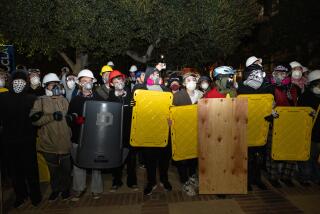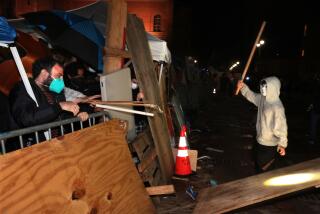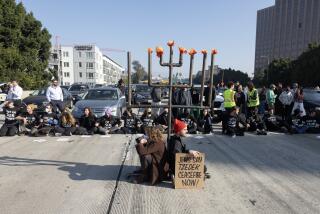George Floyd protests reached deep into rural California. The reactions were mixed, sometimes scary
When two teenagers from the tiny, majority-white Gold Rush town of Angels Camp posted a Facebook flier for a racial justice protest, the threats came immediately.
There was a rumor that ultra-left antifa activists were being bused in from the Bay Area and that organizers were being paid $25 an hour. There were comments from people claiming they had “enough bullets” to take protesters down. There were menacing phone calls, including one from a man in nearby Mokelumne Hill who threatened to “burn down Angels Camp.”
“At the end of it, he said, ‘I’m warning you, there will be hell to pay,’” said Riley Lowell, 18, one of the organizers, who is white.
Alarmed by the threats, city officials — who told The Times in an email that “protests in Angels Camp are very rare on any issue” — set a curfew and declared a local emergency for the town of about 4,000 residents and a seven-member police department.
Since the death of George Floyd, a Black man who died last month after a white Minneapolis police officer knelt on his neck for eight minutes and 46 seconds, the protests that have filled streets in major cities have spread to conservative, mostly white small towns and suburbs.
While protesters in urban areas have been met by police batons, rubber bullets and tear gas, demonstrators in rural California have faced militias, death threats and conspiracy theories.
In Tuolumne County, people threatened to bring guns and dogs to a protest in the park. In Lassen County, people shouted racial slurs at a man who protested alone near the McDonald’s in Susanville. The Black teenage organizer of a demonstration in Plumas County got a message on Facebook calling her a “domestic terrorist.”
In a claim he later walked back, Humboldt County Sheriff William Honsal said antifascists had tried to wreak havoc during a demonstration in Eureka, citing “substantiated law enforcement reports” that there were buses full of antifa protesters in Southern Oregon and the Central Valley.
In Shasta County, where street signs declare there is “No Room for Racism,” militia members in tactical gear showed up to a protest in Redding. Armed militia members also came, at the request of a local business, in anticipation of a protest in the Stanislaus County town of Oakdale that never happened.
“This ‘militia’ has no official standing, no authority and their presence was counterproductive to keeping the peace in the City of Oakdale,” Stanislaus County Sheriff Jeff Dirkse said in a statement. “Their activities were a drain on law enforcement resources and did nothing to protect the city.”
In Angels Camp, a town made famous by Mark Twain in his 1865 short story “The Celebrated Jumping Frog of Calaveras County,” authorities were not anticipating protests. Police Chief Scott Ellis said it “definitely caught us off guard.”
“I just wasn’t expecting it to hit our small county,” he said.
Although the backlash prompted Lowell and her co-organizer, 19-year-old Claudia Loomis, to postpone their demonstration, the teenagers joined community members who decided to show up on June 5 and protest anyway.
Among those in the crowd was Nate Frazier, his wife and their two children. Frazier, who has lived in Calaveras County for 20 years, saw the protest as an opportunity “to open some bigger conversations in the area,” which is 1% Black.
“I never experienced my town this vocal about something that’s so near and dear to me as an African American man who has had negative and positive experiences,” Frazier said. “But there was also the really negative of being forced to talk about and really contemplate on the issues we have in America. This is something that’s so heavy that even in this little town, we’re all reacting to it.”
In neighboring Tuolumne County, which is 80% white, organizers Daelyn Sebold and Morgan Wilkie, who are white, endured the same threats when word spread about the Sonora Stand in Solidarity gathering.
Ahead of the protest, about 200 people met to discuss how to protect businesses. In audio from that meeting shared with The Times, one man asked if he could run over protesters if they bashed his car windows. When someone asked if anyone had a wood chipper, another man responded, “we’ve got chainsaws, we’ve got all kinds of s—.”
At the June 3 protest, about 100 counter-protesters stood nearby, wearing All Lives Matter shirts, Sebold said. One car had a Confederate flag with the word “redneck” on it. When the protesters held nine minutes of silence, the crowd across the street began reciting the Pledge of Allegiance.
Although at times the threats were frightening, Sebold said she wasn’t surprised.
“I did grow up here for a majority of my life, I knew this was going to happen,” the 22-year-old said. “But I also understood that the fear I was feeling was the fear that some people have to face their entire life. I know my purpose and why I needed to do it, I just had to follow through.”
TyAnna Farmer, a Black 17-year-old, and a friend organized a protest outside the Plumas County Courthouse in Quincy. She was bombarded with Facebook messages saying it was going to be a riot and that she was a “domestic terrorist.” People threatened to bring guns.
Still, hundreds of people showed up. It was peaceful.
There, TyAnna read a poem she written about being one of few Black students in her school:
Surrounded in a sea of white, all that can be seen is my Black. Seas of white, slowly rising. Keep your head up, hands forward, keep swimming they say. White waves crash against you, you’re suffocating. They say breathe. I can’t, you say.
TyAnna said there are few Black families in the small Sierra Nevada town, and it gets lonely.
She said it’s become a reflex to pull out her wallet when she walks into stores to avoid suspicious looks. Many times, she said, white classmates have touched or pulled her hair.
TyAnna transferred schools, she said, after fighting with a white student who, she said, spat on her and called her the N-word. The fight, she said, cost her a scholarship and a captain position on the cheer squad.
She was inspired, albeit surprised, by the big crowd at the protest.
“I feel like people are starting to finally open their eyes,” TyAnna said. “Before, people were in denial, saying racism doesn’t exist here. After everything that’s happened in the world, people are starting to realize it’s everywhere. Even Quincy.”
On June 2, Cameron Medico, who is half-Black, began a one-man protest in Susanville — in sparsely-populated, deeply conservative Lassen County. He bought two poster boards from the Dollar Tree and included why he was protesting, as well as the names of those who have died from police brutality, and walked around town.
The first day of his protest, he endured racial slurs and people shouting, “we don’t like your kind around here” and “Black lives don’t matter.” He wasn’t surprised, recounting the time someone left him a doll with a hangman’s noose and a racial slur in the high school locker room.
“What do you expect?” he said. “It’s a small town, there’s not many people of color like me here.”
In the following days, more people began walking with him. At one point, he said, a man flashed his gun at protesters, threatening to shoot them. Medico went to the police.
Despite some of the backlash, Medico is still going out to protest every day.
Inspired by Medico, the local Democratic Party organized a protest march last week that drew scores of people.
Initially, some were scared to participate, said Jake Hibbitts, 33, chair of the Lassen Democratic Party. There had been threats on social media, people saying they’d bring guns and run over protesters. In a small town, Hibbitts said, everyone knows who participates.
“We were reasonably terrified,” said Hibbitts, who is white.
At the end of the march, protesters knelt in the road and chanted, “No justice, no peace!” They were met by a small group shouting, “All lives matter!” and “Cop lives matter!”
But the demonstration was peaceful. Now, Hibbitts said, people want to protest more.
“When I started this, I wasn’t really trying to have all these people do all this stuff. I was just trying to stand up for something that I hold strong,” Medico said. “Maybe we’ll get other small towns to stand up.”
More to Read
Sign up for Essential California
The most important California stories and recommendations in your inbox every morning.
You may occasionally receive promotional content from the Los Angeles Times.












